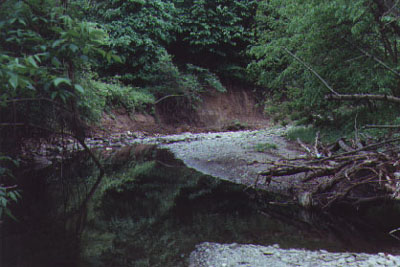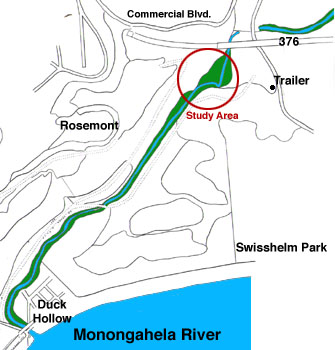Nine Mile Run Greenway Project
Stream Remediation Workshop
A Study of Nine Mile Run
Riparian Plants
Compiled by Choli Lightfoot and Amy Marino
For a complete index of riparian plant which current inhabit Nine
Mile Run, click here.
 Photo by Bob Bingham
Photo by Bob Bingham
The Role of Streamside Vegetation
Streamside vegetation plays a critical role in protecting streambanks and
providing vital habitat for aquatic and semi-aquatic animals. The type
of vegetation present also is important for streambank stability and as
food for wildlife. Streamside vegetation provides many important functions
for the stream, fish and wildlife. Trees and woody vegetation draw water
from the streambanks; this helps to dewater the banks and improve their
stability. In addition, tree roots that hang from the streambanks provide
places for fish and other animals to hide from predators. Leaves falling
from trees provide food for some aquatic insect larvae. Trees also provide
shade for the stream, keeping water temperatures cooler. Cool water holds
more dissolved oxygen.
Vegetation growing alongside the stream and in its floodplain
buffer the stream from runoff pollution. According to the U.S Fish and
Wildlife Service, a forested buffer as narrow as 50 feet can remove the
majority of nitrogen and phosphorus from surface and subsurface runoff.
Source: Firehock, Karen & Doherty, Jaqueline;
"A Citizen's Streambank Reclamation Handbook"; Save Our Streams Program,
Izaak Walton League of America, Inc.; Gaithersburg, MD, 1995
 A typical stream or area is divided into 6 zones, as shown in the image
below. In looking at the riparian plants of the Nine Mile Run area we focused
on plants of Zone 3: Shoreline fringe and Zone 4: Riparian fringe.
A typical stream or area is divided into 6 zones, as shown in the image
below. In looking at the riparian plants of the Nine Mile Run area we focused
on plants of Zone 3: Shoreline fringe and Zone 4: Riparian fringe.
Zone 3: Shoreline fringe
Plants in this zone must be able to withstand being inundated during
storms and drying during drier periods.
Zone 4: Riparian Fringe
Plants in this zone must be able to tolerate both wet and dry soil
as well as periodic inundation.
 A long strip of riparian forset persists along much of the stream
corridor, and is colored green in this map. A variety of native and non-native
species flourish in this riparian corridor.
Documented Riparian Plants in Nine Mile Run
A long strip of riparian forset persists along much of the stream
corridor, and is colored green in this map. A variety of native and non-native
species flourish in this riparian corridor.
Documented Riparian Plants in Nine Mile Run



